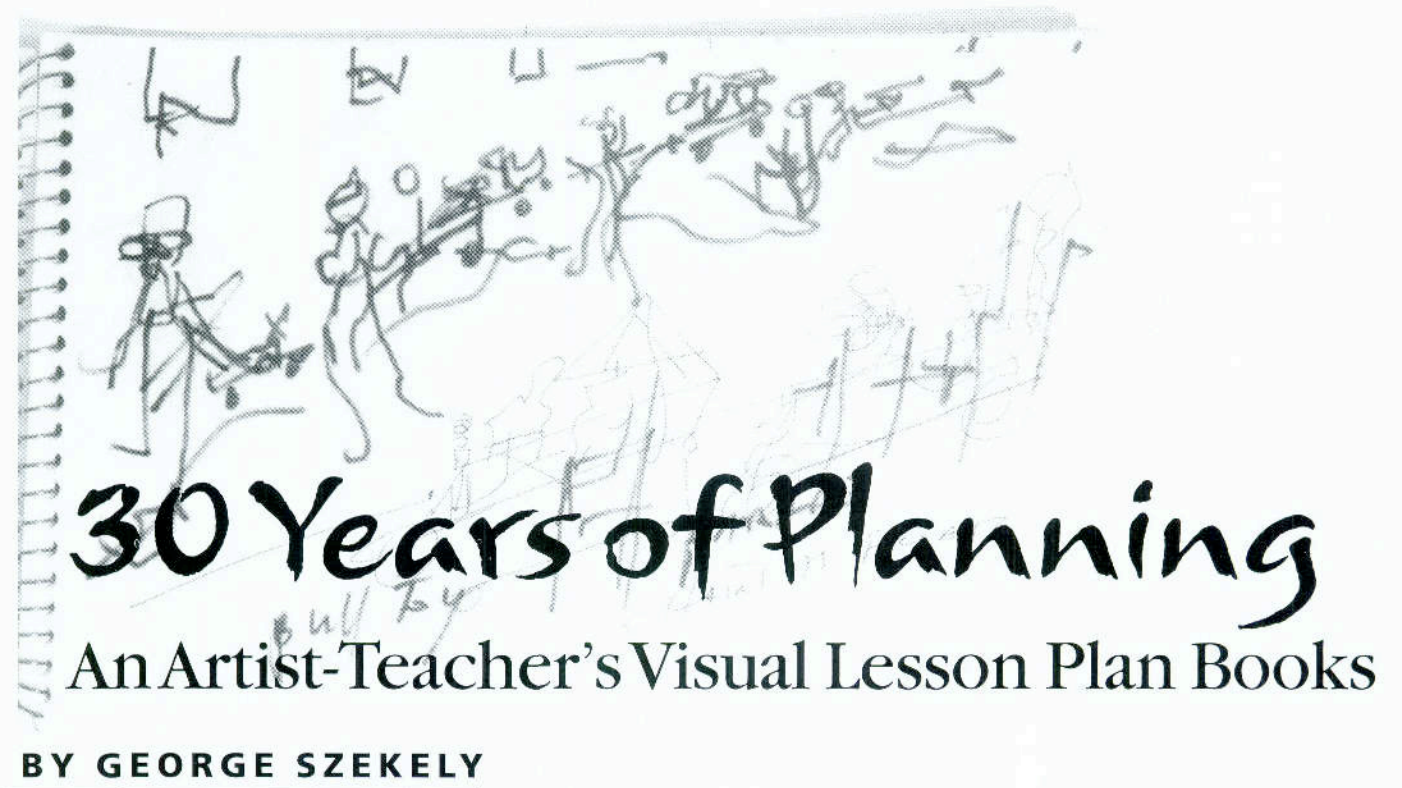Note: 30 Years of Planning, an artist-teacher's visual lesson plan books by George Szenkely4/10/2023 Note: 30 Years of Planning, an artist-teacher's visual lesson plan books by George Szenkely John Michael (1983) mentions the power of visual understanding when making suggestions. “Visual symbols developed by artists help capture unique information that cannot be conveyed through other means of communication. Both verbal and visual skills should be provided and given opportunities to develop creatively. “ An artist's work is defined through many sketchbooks. A sketch or visual plan promotes the search for interesting ideas. Sketch helped me remember that planning my art class is designing for a work of art. What you will see and experience in art class is just as important as what you will say. Children's art inspiration comes from a variety of sources, so a plan cannot just focus on what the teacher is saying. A visual plan is not a cue card or lecture script. They are detailed and sequential designs throughout. Writing and summarizing abstract art lessons to suggest possibilities. Sketching, on the other hand, brings the teacher closer to seeing and experiencing reality. Sketching allows me to enter a room and design spaces and events that say and support what I want to say. Visual design contributes to a sense of drama in art classes. Visual planning is also important because it describes the different ways people think. People with art education visualize their plans and ideas in a sketchbook. In the visual plan, the creative mind is free to roam and compose all the visual possibilities of the art room. While other teachers learn to write lesson plans, the art students in our class are trained in the studio to think and plan visually and to plan art lessons with visual communication. A writer can describe his thoughts and ideas in great detail with just a piece of paper. Artists can efficiently discover vivid descriptions and great ideas in the process of painting. Sketching a visual plan for an art class can help sharpen the visual characteristics of the class. A visual plan highlights our uniqueness as artists in the school and helps preserve this uniqueness. Art permeates the core of all human activity, where there is a concern for how things look and for harmonious order and organization. Seeing and experiencing is best developed visually and encourages continued thinking about art lessons through visual presentation. Art education is about defining our source of ideas so that art students learn independence and confidence in finding their own ideas and strengthen their ability to create their own art plans. Understanding where art class ideas come from is an important aspect of the class. For most teachers, practical lesson plans are self-study. However, visual planning is hands-on, fun, and easily adaptable to individual planning styles and everyday needs. Edie Pistolesi (2001) writes about the importance of good communication of art education ideas: ‘In my planners and in my students’ sketchbooks, I present visual lesson plans, event descriptions, preparations, performances, exhibitions, and object animations in art rooms. These plans include transforming space and surfaces, creating plays with furniture, and experimenting with sound and lighting in the art room. The picture shows an original performance by the teacher and a student play introducing the cash class. Play encourages students to actively engage in lessons and respond visually. Collaborate on text illustrations excerpts from the back of the visual planner pages and clarify displays, object placement, events and planned surprises. Art classes should have a magical quality that can take children out of the school routine and into places of their imaginations. It should not be just a presentation, but a source of inspiration for everyone who enters that special room. The setting of the class should make students feel like children. Art classes at our school are called specials and there should always be something special. It is the art class's mission to recount plastic personal stories, welcome new collections, keep the excitement in the show, and talk about beautiful things. Every art class should be as fun as the best birthday party kids can dream of. The value of an art class does not extend to the teacher's experience, the teacher's plan, but to the meaningful experience itself. Play is the closest thing to an independent artist looking for ideas. What to wear, what to show off, what to have fun – consider design that inspires, not just informs. Play and shop before making art so kids have a chance to discover their own ideas. The value of art lessons does not simply extend to the teacher's experience. Never lose sight of the fun and childhood dreams that connect us best with our students. Landscape, Still Life or Art As artists, children should be involved in creating their own still life, landscape or aerial flight. Art always stems from Jesurak's interests and experiences, and is not a planned art class. Sketching your thoughts helps you identify your inner vision, store and explain it. Recording fleeting, ephemeral ideas will come in handy later for editing and assembling. In your car, on your table, in your pocket, you'll feel at home with an idea book nearby.
0 Comments
Leave a Reply. |
Myungja Anna KohArtist Categories
All
Archives
July 2024
|
Proudly powered by Weebly


 RSS Feed
RSS Feed